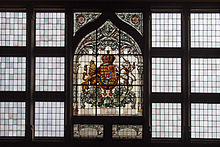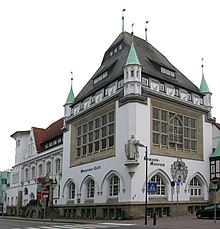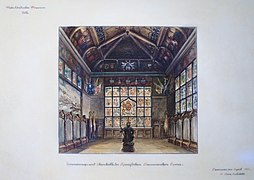Bomann Museum
The Bomann Museum is a museum for Lower Saxony folklore , regional and city history in Celle and the third largest museum in Lower Saxony . It was named after its founder and first museum director Wilhelm Bomann .
history
The Bomann Museum was founded in 1892 as the "Fatherland Museum" and was initially located on Bergstrasse.
Between 1903 and 1907 a new building was built by the architect Alfred Sasse opposite the Celle Castle . During his visit in 1911, Kaiser Wilhelm II visited the museum. In 1928 the name was changed to the "Bomann Museum". In 1993 an extension was added. The Bomann Museum has been united with the Celle Art Museum since 1995 . Another extension in the form of a glass cube was added in 2005.
- Drawing by the architect Sasse 1903
Collections
Prehistory and early history
The museum's collection was created through the many ground conservation activities in the district of Celle from the beginning of the 20th century to the 1950s. Mainly the surface and excavation finds came from the Allertal , the Flotwedel and the side valleys of the Aller, as well as from the Örtzetal . A few objects, mostly from burial mounds from the older and middle Bronze Age , come from the area of the Bergen military training area , the Lohheide and the floating sand areas between Bergen and Hermannsburg . In addition, there were new objects from salvage from construction sites in the old town of Celle and the Celle castle . Most of the excavation finds from the 108 burial mounds, which the Hermannsburg archaeologist Hans Piesker recovered from the Bergen military training area between 1935 and 1944, ended up in the Lower Saxony State Museum in Hanover .
The Bomann Museum has a large number of surface finds , mostly artefacts from Mesolithic sites. They were discovered in the middle Örtzetal - near Hermannsburg, Lutterhof, Oldendorf , Weesen , Baven , Scharnebecksmühle and Schlüpke. They come from the former Pieskers collection, some of which he published in his dissertation . Other sites were in the Fuhseniederung , near Wietzenbruch , Hambühren and Eversen . A settlement of the funnel cup culture (approx. 4200–2800 BC) was discovered in 1936 by Hans Piesker about 800 m east of Dohnsen , on the Lührsberg , a hill 77 m above sea level and about 500 m wide. Archaeological finds from this settlement are also in the holdings of the Bomann Museum.
In 1938 the Bomann Museum bought part of the extensive prehistoric collection of the antique dealer Rudolf Schliekau from Bad Bevensen . It consists mainly of urn finds and burial objects from Bronze Age burial mounds and Iron Age urn cemeteries. Other objects, including deep engraving ceramics . come from Neolithic settlements. The collection also includes stone axes and hatchets.
In the holdings of the Bomann Museum there are still various smaller collections, some of which were bought and some of which were donated to the museum. The oldest collection, which was given to the museum in 1893, comes from the Celle master locksmith W. Kipp († 1930).
- Excavation finds from the Older Bronze Age in the Bomann Museum
Rural cultural history
When the museum was founded, the entire ground floor of a Low German farmhouse, a so-called hall house , was built in the museum building. The living rooms, hall , stables and kitchen (Flett) from the 19th century can be seen. The center of the house was the open hearth .
- Interior of the Bomann Museum
Miniatures collection Tansey
The German-American couple Lieselotte and Ernest Tansey, who lived in Celle during their lifetime, have been collecting miniature portraits since the 1960s . The impetus for this was given by some heirlooms from Mrs. Tansey's mother. Over time, one of the world's largest and most important collections of European miniature painting was created. The works of art date from the late 16th to early 20th centuries. Most of the miniatures are from the Baroque period , with a focus on the Rococo period . They are almost exclusively portraits . First and foremost, rulers and members of the nobility are depicted. These include works from the first heyday in England and later miniatures from France, Germany, Austria and Switzerland. Huguenots who had fled to work in Geneva were originally specialized in the watchmaking industry and enamel technology. Most of the miniatures of the Baroque period were painted in watercolor on parchment . Ivory was not used as a painting surface until the 18th century .
In 1997 the Tanseys transferred 120 selected works of art from their collection to the "The Tansey Miniatures Foundation". The miniatures have been presented to the public in an exhibition in the Bomann Museum in Celle since 2000.
- Miniatures collection Tansey
“August the Strong” by GF Dinglinger
“Gentleman with a purple cape, lady in a patterned dress” by Jakob Ch. Le Blon
Other collections
- Hall of Honor of the Hanover Army
- Craft history
- Industrial history
- National history
- Military history until 1866
- Modern art
- Collection Eberhard Schlotter
- Tom Reichelt Collection
- Urban life in the 19th century
- Urban and rural clothing

Others
- Hermann Löns described the building, which combined all of the architectural styles in Celle, as a “veritable architectural pudding”.
- The museum offers guided tours, lectures, events and a wide range of educational offers.
- Since 1954, the Bomann Museum, in collaboration with the Celle City Archives, has published the series “Celle Contributions to Regional and Cultural History”. 40 volumes have appeared so far.
Personalities
- Mijndert Bertram , 1993–1999 director of the Bomann Museum
- Jochen Meiners, director of the Bomann Museum since 2002
Exhibitions
- May - October 2014: When the Royals came from Hanover , the Welfs as kings on the throne of England
- 2019/2020: Search for origin , Nazi-looted art in the Bomann Museum
- 2019/2020: Cold war & hot beat , the 60s between departure and everyday life
literature
- Kurt Burkhatdt: The Fatherland Museum in Celle. In: Reclam's universe. 24th year 1908, pp. 932-934.
- Wilhelm Bomann: Rural housekeeping and daily work in old Lower Saxony. 1927.
- RWLE Möller : Celle Lexicon. From Abben to Between. Lax, Hildesheim 1987, ISBN 3-7848-4039-6 .
- City of Celle (Ed.): Celle. Celle 1991, ISBN 3-925902-12-0 .
- Hilde Hudemann, Christel Hudemann-Schwartz, Hans-Heinrich Waack: Celle - the old ducal city. Christians, Hamburg 1992, ISBN 3-7672-1145-9 .
- RWLE Möller, Bernd Polster : Celle - the city book. Edition Stadtbuch, Bonn 2003, ISBN 3-00-012605-8 .
Web links
- Website of the Bomann Museum
- Website of the tourist information for the Bomann Museum
- Description of building and coat of arms
Individual evidence
- ^ Helmut Knocke : Sasse, Alfred. In: Dirk Böttcher , Klaus Mlynek, Waldemar R. Röhrbein, Hugo Thielen : Hannoversches Biographisches Lexikon . From the beginning to the present. Schlütersche, Hannover 2002, ISBN 3-87706-706-9 , p. 308 ( online at Google books ).
- ↑ Hans Schimmelpfeng: History of the 2nd Hanoverian Infantry Regiment No. 77. Gerhard Stalling, Oldenburg i. O. 1913.
- ^ Catherine Atkinson: The archaeological collection of the Bomann Museum, Celle
- ↑ https://tansey-miniatures.com/
- ↑ The Tansey Miniatures
- ↑ Contact person Bomann Museum, accessed on August 28, 2020
- ↑ CZ of June 10, 2020
- ↑ [1]
- ^ Nazi looted art in the Bomann Museum
- ↑ Cold war & hot beat
Coordinates: 52 ° 37 ′ 27 " N , 10 ° 4 ′ 46.4" E


















